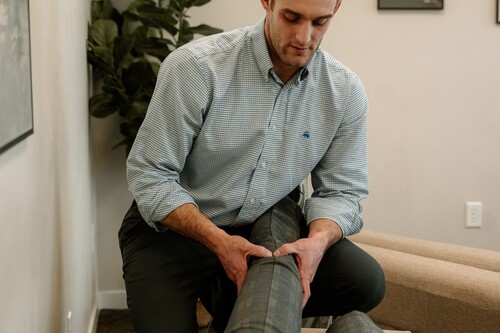Knee Pain and What You Need to Know

Do your knees “click” or “pop” when going up and down the stairs?
Have you noticed swelling or stiffness in your knees after physical activity?
Chronic knee pain affects a significant portion of the population, with an estimated 7 out of 10 Americans experiencing it at some point in their lives. This painful condition can significantly impact daily activities and quality of life.
While surgical interventions like knee replacements may be necessary in severe cases, there are many effective ways to prevent and address knee pain through non-invasive approaches.
Understanding the Roots of Knee Pain
Knee pain can stem from various factors:
- Structural Issues: Degenerative conditions, past injuries, or misalignments in the knee joint itself or surrounding structures (hips, pelvis, feet).
- Muscle Weakness or Tightness: Imbalances in the muscles supporting the knee can lead to instability and pain.
- Ligament or Meniscus Damage: These structures provide crucial stability to the knee joint, and injuries can cause significant pain and dysfunction.
- Nerve Problems: Issues originating from the lower back or pelvis can sometimes radiate pain to the knee.
- Poor Blood Flow: Reduced circulation can hinder healing and contribute to chronic pain.
Preventing Knee Pain and Injuries
Proactive measures can significantly reduce the risk of developing knee problems:
- Consistent Movement: Regular physical activity, even simple activities like walking, helps maintain joint health and flexibility.
- Proper Footwear: Shoes that are a good fit, support your feet, and allow for natural movement is crucial.
- Regular Exercise: Incorporating exercises that strengthen the muscles around the knee, such as squats and lunges, is essential.
- Stretching: Regular stretching improves flexibility and range of motion, reducing the risk of muscle strains and injuries.
- Avoiding Overuse: Resting an injured knee is crucial for proper healing and preventing further damage.
Helping an Injured Knee
When dealing with knee pain, these strategies can help:
- Ice Application: Reducing inflammation and swelling through ice packs.
- Range of Motion Exercises: Gentle movements to maintain flexibility and lubricate the joint.
- Light Stretching: Improving blood flow and reducing stiffness.
- Professional Guidance: Seeking advice from a qualified healthcare professional, such as a chiropractor, can provide personalized treatment plans and address underlying issues.
Finding Relief in Ann Arbor
If you're struggling with joint pain in Ann Arbor, seeking professional guidance is essential. A qualified healthcare provider can accurately diagnose the underlying cause of your pain and recommend appropriate treatment options, including:
- Chiropractic Care: Gentle adjustments to correct misalignments and improve joint function.
- Lifestyle Modifications: Guidance on proper posture, ergonomic adjustments, and weight management.
Chiropractic Care is the Proactive Approach to Addressing Knee Pain in Ann Arbor
By taking proactive steps to prevent knee and Knee pain in Ann Arbor and seeking appropriate treatment when necessary, you can greatly improve your quality of life and enjoy pain-free movement for years to come.
Ready to start your pain-relief journey? Our team is here to help you every step of the way! Schedule your first appointment today.

